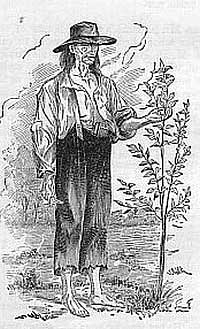
FREE LAND AND FRUIT
By Bob Jamison
Shortly after the Revolutionary War that won independence from England, those who fought so bravely against the British were awarded free land. However, there was a covenant attached.
The wisdom of the new government of this country has been expounded in so many ways such as the simple requirement of a conditional agreement to acquire certain free land was to raise fruit. Even the constitution with the Bill of Rights or amendments is simple to the extent that with only a few words it becomes difficult for most erudite lawyers to challenge it. The same type reasoning is true with fruit trees in order to get this badly needed land as western development expanded.
Then along came this somewhat eccentric character named John Chapman. Born in Leominster, Mass., in l774, Chapman was soon to become a legendary figure that most everyone has read or heard about. He wasn’t a war hero or an educator but yet, he was both.
The idea of fruit on the land was intended to supplement the healthful needs of our pioneers moving west. The powers to be realized that raising crops of vegetables and meat or wild game would be the order of the day for these daring and strong people. But fruit followed the old principal, “An apple a day would keep the doctor away.” In fact, the qualities of fruit in our diet are true today.
Cider was a major market item that rendered needed vinegar and maybe a few other purposes. A by product of the apple presses was apple seeds by the thousands. Chapman, though peculiar in some ways, had the imagination of an astute business man. He would acquire apple seeds and raise apples.
He likely didn’t own a tool or plow according to Nancy Mann Jackson’s story in Colonial America publication. Chapman would allow land owners in the east to plant apple seeds in the style of orchards. From one he would collect apple tree seedlings and sell them to those who required fruit trees. Then he would return and split the money gained with the farmer that had planted his seeds. It was a novel idea that worked so well that Chapman himself eventually acquired twelve hundred acres of apple orchards and became quite wealthy.
The strange thing about this character Chapman was that he never wore shoes; summer or winter. He wore hand-me-down clothes or those he would be given for his apple seeds. They seldom fit. Yet, as he walked through the land folks took him in to spend the night and accepted his complete advice on how to grow apples. He explained that they could be eaten fresh but still had the ability to be canned or dried for future useful and healthful foods.
While accepting the hospitality of many farm families along the way, as it was the custom in those days, Chapman would also ask the family if they would care to hear some stories. At which time, he would impart his deep belief in Christianity and its teachings. For those that could read, he would leave parts of books he carried and on the return trip he would pick them up for others to learn and share his faith. He obviously became Ohio’s first circulating library and indeed, probably it’s first missionary for Christ.
This is a very old but true story. All of us have heard of it and many believe it is a beautiful myth or fairy tale. But John Chapman really lived and did much for agriculture captured with a bit of levity, and especially true Christianity. But of all the tales we have heard about him, he was best known by his given and earned famous nickname, “Johnny Appleseed”.